 Biology 209 – Introduction to Non-Vascular Plants
Biology 209 – Introduction to Non-Vascular Plants
Optional fieldtrips are offered to students where they can choose an ecosystem they would like to investigate. This year the students chose to go to Stanley Park. They looked at a coniferous forest, peatland (Beaver Lake “Bog”) and the intertidal.
The project component of the course requires students to make collections in the field (one bryophyte, fungus, and alga). This activity is primarily designed by the lecture faculty, but I assist with the in-lab work.
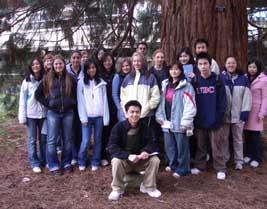 Biology 210 – Introduction to Vascular Plants
Biology 210 – Introduction to Vascular Plants
The fieldtrip for this course is student-directed. Each pair of students selects the name of a tree from a hat. Their assignment is to research information on the tree with reference to scientific name, native location, uses, and biology. In pairs, the students are responsible for presenting information on their tree to the rest of their lab section in the Old UBC Arboretum. They must submit a report individually on their tree.
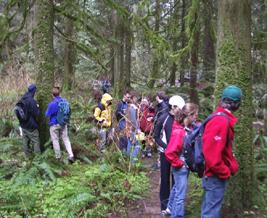 Biology 321 – Bryology
Biology 321 – Bryology
There is a large fieldtrip component to Biology 321. Bryophytes can not be fully appreciated through examination from a dish. There are three mandadory fieldtrips and then a number of additional ones, every other week to different locations. This past year we did a survey of Stanley park, so visited different areas of the park as well as Eagle Ridge. Baden Powell Trail, Lynn Canyon, Pacfic Spirit Park, Agroforestry Trail (UBC South Campus) and Richmond Nature Park (and adjoining Deparmtent of Defense Land).
 Biology 343 – Plants and People
Biology 343 – Plants and People
There are number of fieldtrips for this course: Pacific Spirit Park, Chinatown, UBCFarm, UBC Botanical Garden, and the Anthropology Museum. Activities include a “Day to Dye For” where we spend the morning in lecture and watching a film. In the afternoon we dye fabric using various plant-derived dyes (indigo, madder, turmeric, onion skin, and henna). Another popular activity is the antibiotic assay (Lab #7), where students decide on which plant preparations they would like to test (from home or lab) for antibacterial activity (this year’s winner was garlic!).
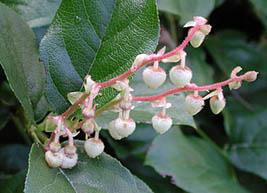 Biology 324 – Introduction to Seed Plant Taxonomy
Biology 324 – Introduction to Seed Plant Taxonomy
There is no formal fieldtrips offered in this course. The students are responsible for a 15 specimen plant collection, for which they go into the field on their own. We did one impromtu fieldtrip to UBCFarm where they could participate in the development of the Medicinal Garden as well as collect for their project.
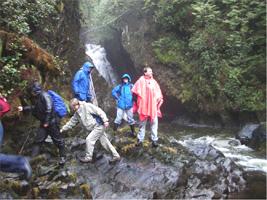 Botany 505A – Bryophyte Fieldtrips
Botany 505A – Bryophyte Fieldtrips
Over the last few years I have been involved in the course, we have done fieldtrips to Burns Bog, Jervis Inlet (in quest of the elusive Takakia), Stanley Park (as part of of a webiste/inventory project), and Bamfield. There is an assignment component which is used for evaluation.
 Biology 140 – Elective on Cryptic Botany
Biology 140 – Elective on Cryptic Botany
There is a fieldtrip to the Agroforestry Trail at UBCFarm in the first week of this elective, to introduce students to the cryptic organisms commonly studied by botanists We therefore look at bryophytes, fungi, and algae. Students are required to complete a written activity during the walk.
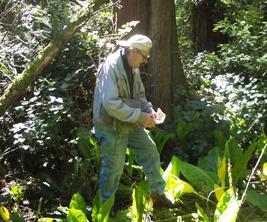 Fieldtrips with Experts
Fieldtrips with Experts
Going into the field is important for my professional development and I am so fortunate to be able to spend time with Dr. Wilf Schofield. He is a world renowned bryologist and author. We have shared many hours investigating and collecting bryophytes in many locations.
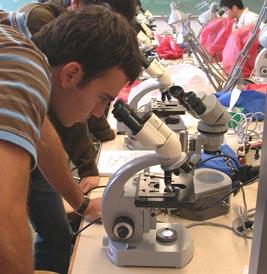 Laboratory Activities
Laboratory Activities
The laboratory experience for students is invaluable. Lab is where students get to interact with living organisms. Microscopy and observational skills are essential for all biologists.
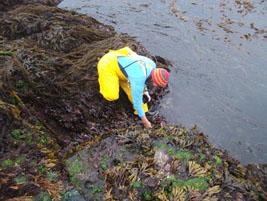 Collecting Material for Classes
Collecting Material for Classes
A very important part of my job as an instructor is to collect living material for the courses I teach. This takes me out in the field on a regular basis. I visit the intertidal, forests, ponds, gardens, and ditches.
Student volunteers sometime accompany me on collecting trips.
